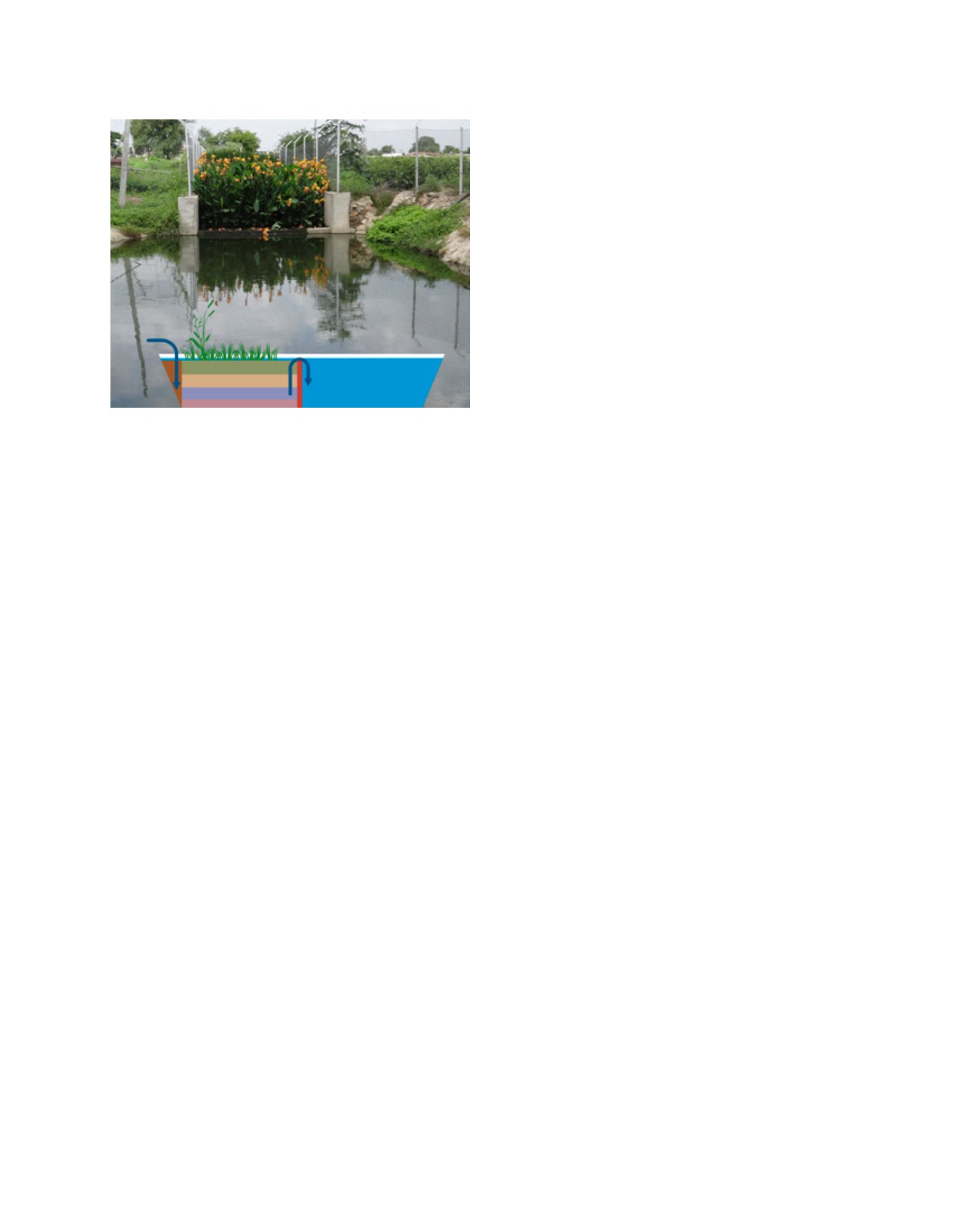

[
] 91
access
to
water
and
sanitation
for
all
Indeed, raw wastewater irrigation is a centuries-old practice,
particularly in the dry summer months. Now, however, market
demand, soil health, rainfall patterns, and the characteristics
of the wastewater itself, have changed, making it necessary to
question this ancient practice.
Apart from nutrients such as nitrogen, sulphate and
phosphate, raw wastewater often contains pathogens, salt,
suspended solids, xenobiotics and heavy metals, although
wastewater generated by resource-poor semi-arid tropical
villages rarely shows heavy metal contamination comparable
to urban or peri-urban wastewater. The salt and suspended
solid deposits can significantly deteriorate the physical
property and fertility of the soil exposed to prolonged raw
wastewater irrigation, particularly in the semi-arid tropics
where rainfall is often too little to wash the contaminants
from the top soil through run-off.
The pathogens present in wastewater pose a risk to the
farmer, consumer and other stakeholders in the value chain,
particularly when salad crops and vegetables are grown
using raw wastewater. Many farmers accept the health risks
of parasitic worms, protozoa, viruses, and bacteria as occu-
pational hazards as they cannot afford treatment for some
of the health problems caused by exposure. Farmers irrigat-
ing with wastewater tend to have higher rates of helminth
infection than those using freshwater.
23
Infection to skin and
nails may also occur among these farmers.
24
In the absence
of proper labelling, consumers and retailers often remain
unaware of the health risks of such pathogen-infected farm
produce, for instance helminth infections.
The potential of constructed wetland to enable better
rural wastewater management
It is estimated that, unlike developed nations which treat
about 70% of their wastewater, the treatment capacity of
countries located in the semi-arid tropics is between 8 and
28%.
25
Conventional sewage technologies, which are diffi-
cult to maintain and operate to full capacity even in urban
environments, seem unlikely to be the solution to wastewater
pollution in resource-scarce villages.
26
Constructed wetlands
(CW) are considered to be a technical, economical, and envi-
ronmentally sustainable solution for wastewater treatment
in small communities since they are efficient in removing
diverse pollutants.
27
The various types of CWs used over
the last four decades can be grouped into two broad catego-
ries: Free Water Surface (FWS) wetlands, which involve the
use of a pond, and Subsurface Flow (SSF) wetlands, which
make use of dry surfaces. One major advantage of SSF-CWs,
though slightly more expensive than FWS-CWs due to the
cost of the filtering medium, is better control of mosquitos.
Despite their apparent simplicity, CWs are complex ecosys-
tems created and influenced by many physical, chemical and
biological processes. The CWs involve basic biogeochemi-
cal processes such as filtration, sedimentation, plant uptake
or phytoremediation and microbial degradation in remov-
ing contaminants from wastewater. Such systems, devoid of
chemicals and moving mechanical parts, have a low operat-
ing and maintenance cost. As common gardening skills are
sufficient to maintain the system, CWs are a feasible waste-
water management solution for small, rural communities
with a limited power supply and resources.
The performance of CWs is being evaluated in the
field as part of an ongoing Indo-European Union project,
Water4Crops, funded by the Department of Biotechnology,
Government of India (
€
3 million) and the European Union’s
Seventh Framework program (FP7) (
€
6 million). The project
has involved 22 European and 12 Indian partners. The exper-
imental facility at ICRISAT provided scope to compare the
phytoremediation potential of several macrophytes in differ-
ent combinations over a period of three years for the greywater
generated by a nearby urban household. A total of twelve
constructed wetlands sown with different plant species:
Typha
latifolia
,
Cana indica
,
Cymbopogon sp
.,
Pennisetum purpureum
,
Pennisetum purpureum
X
Pennisetum americanum
,
Brachiaria
mutica
, and floating macrophytes such as
Eichornea crassipes
and
Pistia stratiotes
were evaluated. Studies with SSF
28
as well
as FWS-CWs
29
have clearly shown potential. SSF-CWs sown
with
Typha latifolia
and/or
Cana indica
were found to be the
most efficient and flexible and were subsequently scaled-up.
Demonstration of constructed wetland in villages
The scaling up of CWs in different villages has been carried
out as part of various developmental projects supported by
the Indian government and Corporate Social Responsibility
projects (Table 1) to reveal possible bottlenecks at a techni-
cal, social or policy level. The existing trust base in different
watersheds towards scientific development has now given the
confidence for CWs to be used for the treatment of wastewa-
ter in these villages. The scaling up process involves several
stages including an awareness campaign, site selection,
construction, commissioning and the reuse of treated waste-
water for safe irrigation practices. In the watershed villages,
construction and commissioning was carried out involving
local NGOs, partners and villagers. The activity was selected
as part of an ongoing project, named
Bhoo-Samrudhi
, and was
funded by the Government of Karnataka. The site-selection
and design of suitable locations in various districts covered
under the project were provided to the district authorities
by the Panchayat Raj Engineering Department, Karnataka.
Constructed wetlands are the one of the most cost-effective solutions for
treating wastewater at community level
Treated water
Filter bed
consisting of layers
of gravel and sand
Wastewater
inlet
Image: ICRISAT
















